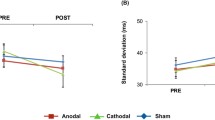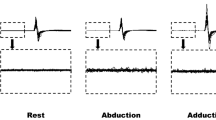Summary
Cortical DC shifts preceding and accompanying the execution of five different bimanual motor tasks were analysed in 20 subjects. All tasks required repetitive flexions and extensions of the two forefingers for a period of at least six seconds. The temporal and spatial structures organization varied in the different tasks: (1) Simultaneous agonistic performance (forefinger flexion on both sides), (2) simultaneous antagonistic performance (e.g. flexion of the right, extension of the left forefinger), (3) sequential agonistic performance, (4) sequential antagonistic performance, (5) uncoordinated flexions and extensions of the two forefingers. Compared to (1) and (2), conditions (3) and (4) included a temporal delay between the performance of the two forefingers; compared to (1) and (3), conditions (2) and (4) required the subjects to perform movements of opposite directions with their two forefingers. Effects of the temporal factor (T; simultaneous vs. sequential) and the spatial factor (S; agonistic vs. antagonistic) on cortical DC shifts were investigated. The voluntary initiation of each motor task was preceded by a Bereitschaftspotential (BP). The performance of the complex tasks (1–4) was accompanied by a slow negative DC potential shift (N-P). In general, the BP did not differ depending on the temporal or spatial structures of the tasks (1–4). However, amplitudes of N-P (i.e. during tasks) were influenced by the temporal factor with significantly larger amplitudes in sequential than in simultaneous tasks. This difference was not a global phenomenon in all recordings but was selectively found in the recordings over the fronto-central midline. The spatial factor had no influence on N-P. It is suggested that the timing-dependent increase of N-P reflects greater activation of the fronto-central midline including the supplementary motor area (SMA) in sequential as compared to simultaneous movements. Furthermore, the data substantiate the hypothesis that the fronto-central midline (including the SMA) is rather involved in the temporal than the spatial coordination of bimanual motor tasks.
Similar content being viewed by others
References
Becker W, Hoehne O, Iwase K, Kornhuber HH (1972) Bereitschaftspotential, prämotorische Positivierung und andere Hirnpotentiale bei sakkadischen Augenbewegungen. Vision Res 12: 421–436
Benecke R, Dick JPR, Rothwell JC, Day BL, Marsden CD (1985) Increase of the Bereitschaftspotential in simultaneous and sequential movements. Neurosci Lett 62: 347–352
Boschert J, Deecke L (1986) Cerebral potentials preceding voluntary toe, knee and hip movements and their vectors in human precentral gyrus. Brain Res 376: 175–179
Brinkman C, Porter R (1978) Supplementary motor area in the monkey: activity of neurons during performance of a learned motor task. J Neurophysiol 42: 681–709
Chauvel PC (1976) Les stimulations d'aire motrice supplementaire chez l'homme (thesis) Université de Rennes, Rennes
Deecke L (1985) Evidence from finger and toe movement-related potentials for SMA activation prior to human volitional acts. In: Creutzfeldt OD, Eccles JC, Fromm Chr, Wiesendanger M (eds) Cerebral events in voluntary movement: the supplementary motor and premotor areas. Exp Brain Res 58: A11–A12
Deecke L, Boschert J, Brickett P, Weinberg H (1985a) Magnetoencephalographic evidence for possible supplementary motor area participation in human voluntary movement. In: Weinberg H, Stroink G, Katila T (eds) Biomagnetism: application and theory. Pergamon Press, Oxford London, pp 369–372
Deecke L, Engel M, Lang W, Kornhuber HH (1986) Bereitschaftspotential preceding speech after holding breath. Exp Brain Res 65: 219–223
Deecke L, Lang W, Heller HW, Hufnagl M, Kornhuber HH (1987) Bereitschaftspotential in patients with unilateral lesions of the supplementary motor area. J Neurol Neurosurg Psychiat 50: (in press)
Deecke L, Grözinger B, Kornhuber HH (1976) Voluntary finger movement in man: cerebral potentials and theory. Biol Cybern 23: 99–119
Deecke L, Heise B, Kornhuber HH, Lang M, Lang W (1984) Brain potentials associated with voluntary manual tracking. Ann N Y Acad Sci 374: 361–372
Deecke L, Kornhuber HH (1978) An electrical sign of participation of the mesial “supplementary” motor cortex in human voluntary finger movements. Brain Res 159: 473–476
Deecke L, Kornhuber HH, Lang W, Lang M, Schreiber H (1985b) Timing function of the frontal cortex in sequential motor and learning tasks. Human Neurobiol 4: 143–154
Deecke L, Scheid P, Kornhuber HH (1969) Distribution of readiness potential, pre-motion positivity and motor potential of the human cerebral cortex preceding voluntary finger movements. Exp Brain Res 7: 158–168
Freund H-J (1985) Clinical aspects of premotor function. Behav Brain Res 18: 187–191
Freund H-J, Hummelsheim H (1985) Lesions of the premotor cortex in man. Brain 108: 697–733
Goldberg G (1985) Supplementary motor area structure and function: review and hypothesis. The Behavioral and Brain Sciences 8: 567–616
Goldberg G (1986) unpublished manuscript
Goldenberg G, Wimmer A, Holzner F, Wessely P (1985) Apraxia of the left limbs in a case of callosal disconnection: the contribution of medial frontal lobe damage. Cortex 21: 135–148
Grözinger B, Kornhuber HH, Kriebel J (1979) Participation of mesial cortex in speech: evidence from cerebral potentials preceding speech production in man. In: Creutzfeldt OD, Scheich H, Schreiner Chr (eds) Hearing mechanisms and speech. Exp Brain Res (Suppl II) pp 189–192
Grünewald G, Grünewald-Zuberbier E, Hömberg V, Netz J (1979) Cerebral potentials during smooth goal-directed hand movements in right-handed and left-handed subjects. Pflügers Arch 381: 39–46
Heuer H (1984) On re-scaleability of force and time in aiming movements. Psychol Res 46: 73–86
Heuer H, Wing AM (1984) Doing two things at once: process limitations and interactions. In: Smyth M, Wing AM (eds) The psychology of human movement. Academic Press, London, pp 183–213
Homan RW, Herman J, Purdy P (1987) Cerebral location of the 10–20 system electrode placement. Electroencephal Clin Neurophysiol 66: 376–382
Jonas S (1981) The supplementary motor region and speech emission. J Comm Disord 14: 349–373
Jung R, Altenmüller E, Natsch B (1984) Zur Hemisphärendominanz für Sprache und Rechnen: elektrophysiologische Korrelate einer Linksdominanz bei Linkshändern. Neuropsychologia 22: 755–775
Kelso JA, Southard DL, Goodman D (1979) On the co-ordination of two-handed movements. J Exp Psychol Human Percept Perform 5: 229–238
Kornhuber HH (1984) Attention, readiness for action and the stages of voluntary decision — some electrophysiological correlates in man. In: Creutzfeldt O, Schmidt RF, Willis WD (eds) Sensory-motor integration in the nervous system. Exp Brain Res Suppl 9: 420–429
Kornhuber HH, Deecke L (1965) Hirnpotentialänderungen bei Willkürbewegungen und passiven Bewegungen des Menschen: Bereitschaftspotential und reafferente Potentiale. Pflügers Arch 284: 1–17
Lang W, Lang M, Kornhuber A, Deecke L, Kornhuber HH (1983) Human cerebral potentials and visuomotor learning. Pflügers Arch 399: 342–344
Lang W, Lang M, Kornhuber A, Deecke L, Kornhuber HH (1984) Brain potentials related to voluntary hand tracking: motivation and attention. Human Neurobiol 3: 235–240
Lang W, Lang M, Kornhuber A, Kornhuber HH (1986) Electrophysiological evidence for right frontal lobe dominance in spatial visuomotor learning. Arch Ital Biol 124: 1–13
Lang W, Lang M, Podreka I, Suess E, Müller Ch, Steiner M, Deecke (1987a) Functional imaging (Tc 99m-HMPAOSPECT) and movement-related brain potentials in a joint study of human visiomotor learning. J Cerebral Blood Flow Metabolism 7: S314
Lang M, Lang W, Uhl F, Kornhuber A, Deecke L, Kornhuber HH (1987b) Slow negative potential shifts indicating verbal cognitive learning in a concept formation task. Human Neurobiol 6: 183–190
Lang W, Lang M, Podreka I, Steiner M, Uhl F, Suess E, Müller Ch, Deecke L (1988a) DC-potential shifts and regional cerebral blood flow reveal frontal cortex involvement in human visuomotor learning. Exp Brain Res (in press)
Lang W, Lang M, Uhl F, Kornhuber A, Deecke L, Kornhuber HH (1988b) Left frontal lobe in verbal associative learning — a slow potential study. Exp Brain Res 70: 99–108
Laplane DJ, Talairach V, Meininger V, Bancaud J, Orgogozo JM (1977) Clinical consequences of cortectomies involving the supplementary motor area in man. J Neurol Sci 34: 301–314
McCallum WC, Cooper R, Pocock PV (1987) Brain slow potential and ERP changes associated with operator load in a visual tracking task. Electroenceph Clin Neurophysiol (in press)
Oldfield (1971) The assessment and analysis of handedness. The Edinburgh Inventory. Neuropsychologia 9: 97–113
Penfield W, Welch K (1951) The supplementary motor area in the cerebral cortex of man. Arch Neurol Psychiatr 66: 289–317
Picton TW, Hillyard SA (1972) Cephalic skin potentials in electroencephalography. Electroenceph Clin Neurophysiol 33: 419–424
Ploog D (1981) Neurobiology of primate audio-vocal behavior. Brain Res Rev 3: 35–61
Roland PE (1984) Organization of motor control by the normal human brain. Human Neurobiol 2: 205–216
Schmidt RA, Zelaznik HN, Hawkins B, Frank JS, Quinn JT (1979) Motor-output variability: a theory for the accuracy of rapid motor acts. Psychol Rev 86: 415–451
Schreiber H, Lang M, Lang W, Kornhuber A, Heise B, Keidel M, Deecke L, Kornhuber HH (1983) Frontal hemispheric differences of the Breitschaftspotential associated with writing and drawing. Human Neurobiol 2: 197–202
Shibasaki H, Barrett G, Halliday E, Halliday AM (1980) Components of the movement-related cortical potential and their scalp topography. Electroencephal Clin Neurophysiol 49: 213–226
von Holst E (1939) Die relative Koordination als Phänomen und als Methode zentralnervöser Funktionsanalyse. Ergebn Physiol 42: 228–306
Author information
Authors and Affiliations
Rights and permissions
About this article
Cite this article
Lang, W., Lang, M., Uhl, F. et al. Negative cortical DC shifts preceding and accompanying simultaneous and sequential finger movements. Exp Brain Res 71, 579–587 (1988). https://doi.org/10.1007/BF00248750
Received:
Accepted:
Issue Date:
DOI: https://doi.org/10.1007/BF00248750




